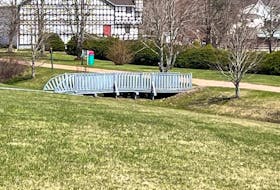There are effective and less expensive ways to address road safety in Nova Scotia than pouring hundreds of millions of tax dollars into twinning provincial highways, says a University of New Brunswick engineering professor and highway safety expert.
“I find it a little bit offensive when the politicians kind of override a broader network of analysis that engineers would typically go through to try to identify those alternatives that are perhaps more cost-effective,” said Eric Hildebrand, reacting to the hoopla surrounding Prime Minister Justin Trudeau’s announcement on Tuesday in Sutherlands River, where he pledged $90-million toward twining a 38-kilometre section of well-travelled Nova Scotia highway.
The province is on the hook for the remainder of the total $285 million construction cost of building a four-lane highway between Sutherland’s River and Antigonish.
“My position is that in a lot of cases there are more effective alternatives available to spend that money, to save lives and reduce accidents. Politicians score some brownie points but show me what else the $90 million would have been able to do.
The $285 million figure does not include the full cost of maintaining the infrastructure over the 20-year life of the contract. The province will spend a total of $390 million over seven years to build four twinning projects in the province.
“No. 1 is twinning is very effective and certainlynecessary in certain situations but my main beef is that you have these political announcements and everybody is shaking hands and everybody is happy,” said Hildebrand. “There’s usually a localgroup that’s quite emotional about it, they’ve been
affected by collisions in the past, and so on.
“From an engineering perspective, there’s a very structured way, a system that you go through to identify those locations that would benefit most from upgrading, in terms of rumble strips, climbing lanes, straightening out alignment, minor improvements, rather than twinning. I’d love to see the study that shows that particular stretch of road on Highway 104 had been earmarked as a top priority rather than re-striping the roads twice a year instead of once a year, or a couple of atgrade intersections or an interchange, or providing passing sections on other stretches of road.”
There have been 414 vehicle accidents and 16 fatalities since 2009 on the Sutherland’s River and Antigonish section of road to be twinned. But Hildebrand says such numbers could be misleading.
“The reality is that fatalities happen all over the province and the first thing they’ll do is spout that there were 19 fatalities over the last 15 years, and yes, that’s a horrible thing but put that in perspective of total fatalities every year in the province, and are there other sections of road that maybe have half the volume that have just as many fatalities? There is a very structured approach to identifying those spots that need work more than others that would benefit from improvements.”
Furthermore, he says the province’s highways need a lot of work to meet basic engineering standards.
“Quite frankly, I think Nova Scotia has a lot of work to do just to upgrade roadside safety that would include proper installation of guide rails, bridge rails . . . bridge piers that are too close to the side of the road that should be shielded by guide rail. A lot of provinces are bad but in particular in Nova Scotia you see these things that don’t meet current practise and standard.”
In April 2017, the Nova Scotia government committed $390 million over seven years to improve a number of highways including the twinning of sections of Highways 104, 101 and 103, as well as the construction of a fourlane, divided, 8.7-kilometre road between Burnside and Bedford.
The twinning projects were not a priority for the province a few years ago. A Department of Transportation report released last year showed that in 2015 the department completed safety studies on the 101, 103 and 104 which made a series of shor-t, medium- and long-term recommendations to the provincial government on how to improve highway conditions.
But under public pressure, the province commissioned CBCL Limited Consulting Engineers to study eight individual corridors to determine the feasibility of using tolls to twin sooner. That sparked a public consultation process, drawing feedback from more than 7,000 Nova Scotians.
“We then took what we heard and developed a focused and unprecedented infrastructure program for the province,” said Marla MacInnis, Department of Transportation spokeswoman.
“We’ve concluded that twinning is the ultimate solution to significantly reduce the risk of head-on collisions . . . These projects will make our roads safer for generations to come.”
The department will also spend about $30 million over the next seven years for safety improvements that include improving grades at intersections, adding passing, climbing lanes and turning lanes as well as roundabouts.
But Hildebrand remains unconvinced that the province is taking a pragmatic, thoughtful approach in committing to the mega-project.
“I take issue with the emotion, the political process that overrides the more objective approach of looking at this.”









